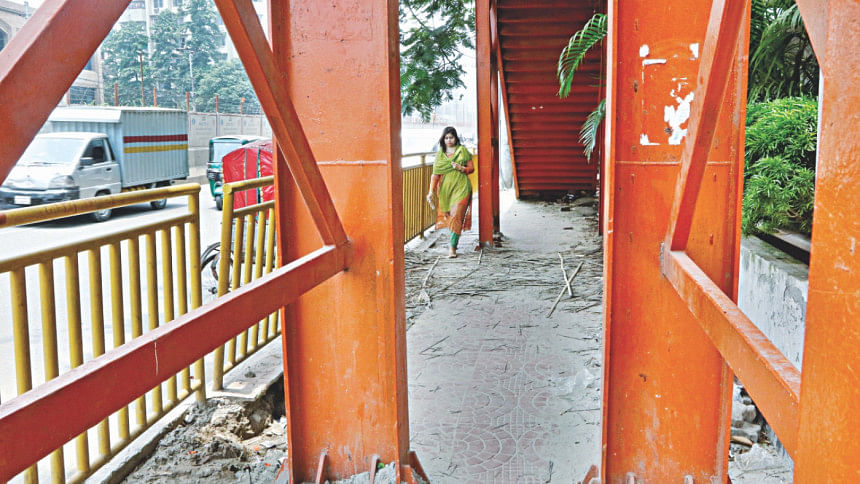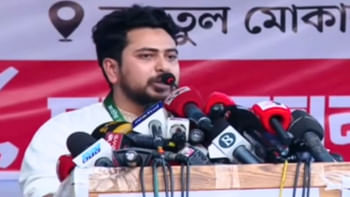Footbridges at the cost of footpaths

Footbridges are common in Dhaka, making the lives of pedestrians easier in a city with maddening traffic.
But on the flipside, some of these footbridges’ columns take up the entire width of the footpath, leaving little room for pedestrians to walk freely. The footpaths also have metal fencing, further restricting movement.
People need to squeeze through the small gap between the fencing and columns -- often forced to walk sideways.
One such footbridge is in Paribagh. It has a shade, and people from all walks of life use it every day. But it obstructs the footpath on both sides of the road. During peak hours, a large number of people have to walk through the small and cramped space under the stairs.
“I use this footbridge often, but it’s annoying as it hampers free movement of pedestrians instead of easing the commute,” complained Dolon Sharkar, who uses this route to go to work in Farmgate.
Another footbridge in front of Government Titumir College in Mohakhali causes the same problem. “People often have to walk on the main road when crossing the base of the bridge, as the small space on the footpath is too crowded. Like others, I had to get used to this,” said Druti Akhter, an honours student at the college.
Between Gulshan-1 and Link Road, there is a footbridge that blocks the way of pedestrians. The footbridge is rarely used by locals, but the footpath underneath is frequented by office-goers.
“The roads stay jam-packed and footpaths are occupied by large structures; where are we supposed to walk?” wondered Ashraf Khandaker, a private job holder.
Not only is the space under the stairs constricted, it is also dirty. A sudden stench of urine and trash assaults the pedestrians’ senses when crossing these parts of the footpath.
Moreover, the flower pots that were set up on the footbridges have dried up, defeating their initial purpose of beautification.
There are 30 and 51 footbridges in Dhaka South City Corporation (DSCC) and Dhaka North City Corporation (DNCC) respectively, according to officials.
Regarding the issue of taking up footpath space, executive engineer (civil) of DNCC, Md Farhad, said, “It is true that the footbridges have obstructed walking space in some areas. But the next time we have to construct one, we will hire consultants who can suggest ways to keep the walkways free.”
Currently a footbridge is under construction on Pragati Sarani. The executive engineer said the work will be completed within this month and it will not take up walking space.
However, upon a visit to the site, this correspondent found that the bridge’s columns were blocking the footpath.
Several city corporation officials said “the city wasn’t planned properly” and thus pedestrian movement was not taken into consideration when building footbridges.
On the issue of cleanliness and beautification, executive engineer of DSCC, Rajib Khadem, said, “We try our best to clean up the bridges every now and then. Besides, we try to plant flowers and replace them when they wither.”
“But city dwellers should also be more responsible in keeping Dhaka clean. Some people intentionally destroy plants and use flower pots as trash cans,” he added.
Architect Iqbal Habib, joint secretary of Bangladesh Poribesh Andolon (Bapa), said, “According to the Strategic Transportation Plan for Dhaka, pedestrians should be given higher priority but this rule is hardly followed.”
“Installing footbridges randomly is an unwise idea,” he said, adding that if the positioning of the city’s footbridges was reassessed, many would have to be removed or shifted.
When asked about better, cleaner alternatives, he referred to a competition arranged by DSCC with Institute of Architects, where the professionals submitted designs showing how the city’s traffic system can be planned without obstructing pedestrian movement.
“When we construct elevated expressways and metro rail, we do not hesitate to acquire adjacent land if required. Why can’t they (administration) do the same for pedestrians?” he asked.

 For all latest news, follow The Daily Star's Google News channel.
For all latest news, follow The Daily Star's Google News channel. 



Comments